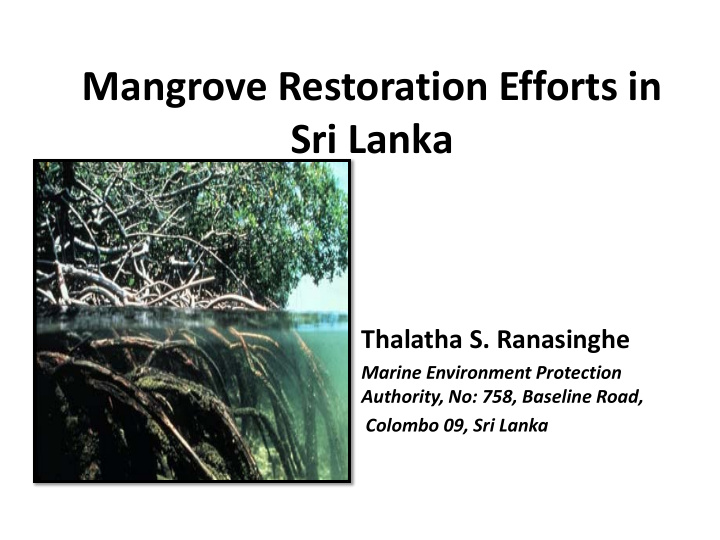



Mangrove Restoration Efforts in Sri Lanka Thalatha S. Ranasinghe Marine Environment Protection Authority, No: 758, Baseline Road, Colombo 09, Sri Lanka
Location Map of Sri Lanka
Including……… • Introduction • Materials and methods • Current status of mangroves • Evaluation of Results in Sri Lanka • Discussion • Study sites o Rekawa Lagoon • Conclusion o Negombo Lagoon o Puttalam Lagoon o Madu Ganga • Objectives
CURRENT STATUS OF MANGROVES IN SRI LANKA • Associated in 22 brackish water bodies • Vegetation is estimated ~ 12,000 ha. • Many benefits - economic goods and ecological services. • Habitat degraded due to human activities. • increase of population density • Attempts taken to restore mangrove
Six Study Sites Puttlam lagoon two sites Negombo lagoon two sites Madu Ganga Rekawa lagoon one site one site
Rekawa lagoon • Located about 200 km south of Colombo in Hambantota District. • Extent of the lagoon is about 250ha • Mangrove and scrub forest (about 200 ha.) surround the lagoon
• Rekawa lagoon is shallow with the water depth averaging 1.4 meters. • ~5,400 people living • About half of the population is engaged in sea and lagoon fishing.
Negombo Lagoon • Large estuarine lagoon in Gampaha District, south-west of Sri Lanka. • Located about 35 km away from Colombo. • Fed by number of small rivers and a canal.
Negombo Lagoon Surrounded by a densely populated region. The land is used for • fishing and agriculture. People in the area are engaged on lagoon fishing and shrimp • industry. Mangrove cover is depleting rapidly due to land clearing for large- • scale shrimp aquaculture.
Puttalam Lagoon • Largest mangrove patch in Sri Lanka. • Coastal communities depend on lagoon fishery and mangrove forests for their survival. • Heavy exploitation by coastal community . • large-scale shrimp farming and agriculture.
Puttlam Lagoon More than 3000 ha of mangroves lands were converted to shrimp farms.
Madu ganga • The lakes Madu Ganga is located on the south-western coast of Sri Lanka. • Madu Ganga has one of the most unique biodiversity. • These vegetation types comprise a total of 303 species of plants.
Pic of madu ganga Madu Ganga
Objectives of the Study • To compare sustainability of six planting sites • Study environmental suitability for the mangrove planting • To compare increase of ecological & economical values of study sites • To study reasons for failures
Materials used: • Reports on Mangrove restoration projects • Research papers and presentations done by researchers in Sri Lanka. • Questionnaires – 20 individuals per site • Test kits -chemical/physical parameters in lagoon water.
Methods applied for the study: • Discussions with project leaders and participants . - compare number of plants succeeded - find out reasons for the failures • On-site observations and photographs .
• Questionnaires and interviews with community /20 individuals in each site – Increase of ecological & economical values • Water Quality analysis - Study environmental suitability for the mangrove planting - Water Quality parameters measured; pH, salinity, Temp, Conductivity, DO
% of survival of plants 100 90 80 70 60 50 40 % of survival of plants 30 20 10 0 Study sites
Variation of Water Quality Parameters at Six Sites 35 30 Temperature (0C) 25 DO(mg/l) 20 15 Conductivity (ms/cm) 10 pH 5 0 Salinity (ppm) Study sites
Increase of ecological and economical values after re-plantation 18 No. of people with the positive answers 16 14 12 10 Increase of Ecological values 8 6 Increase of Economical values 4 2 0 Study sites
Discussion • Among 6 mangrove re-planting sites, identified successful and unsuccessful results. In Rekawa Lagoon and Madu Ganga sites , • Low salinity conditions. • Lack of monitoring after planting. • The poor species selection without adequate site assessment • Poor coordination among institutions and the community
Sites at Negombo and puttlam Lagoons where success; • Suitable environmental conditions • Monitoring after planting • Correct species selection
Mangrove plantation at Kalpitiya
Mangrove plantation at Anawasala
Conclusion • Increase of ecological/economical values in 4 success sites. • Water quality impact on the growth of mangrove plants Recommendations: Building awareness among villagers, school children, government/NGO officials. Carryout more researches on mangrove habitats. Introduce appropriate technology and suitable legislations.
Recommend
More recommend